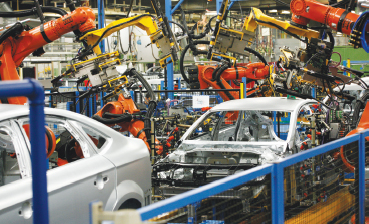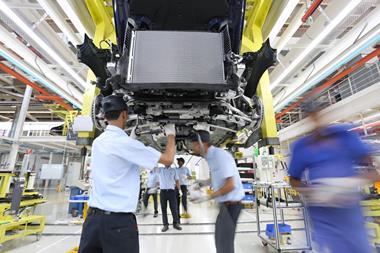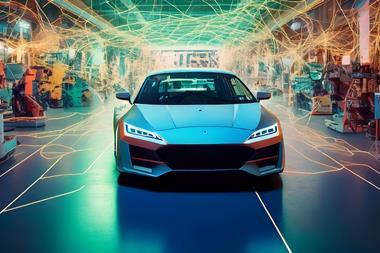At Ford of Europe’s flagship facility in Belgium investment in flexible production and supply has made the plant one of the company’s most successful operations
Ford of Europe has increased the production and process capacity at its seven vehicle assembly plants to almost 100 per cent – a 40 per cent improvement over the past eight years – making it one of Europe’s most efficient and productive automotive manufacturers. The improvements have been driven by investment in production efficiency, supplier parks, advanced logistic systems and revised in-plant work arrangements.
Ford has two commercial vehicle plants – Kocaeli in Turkey, and Southampton in the UK – as well as four plants dedicated to small, medium and larger cars: Cologne, Germany, which produces Fiesta and Fusion; Saarlouis, Germany, where Focus and C-MAX are made; Genk, Belgium, which assembles Galaxy, S-MAX and the new Ford Mondeo, and St. Petersburg, Russia, where the Focus is built. There is also a flexible plant in Valencia, Spain, which produces the Ka, Fiesta and Focus simultaneously.
 One of the company’s key goals was to improve asset utilisation by bringing capacity in line with demand.
One of the company’s key goals was to improve asset utilisation by bringing capacity in line with demand.
Another was to increase production flexibility – adjusting the daily build schedule between models – in order to fulfil customer orders more quickly and respond to changes in consumer demand. Significantly, the manufacturing equipment that allows this flexibility also can be re-programmed to accommodate new models, substantially reducing the investment required when models change.
Such flexibility also applies between plants. If demand for a particular vehicle is beyond the capacity of the model’s main plant, additional units can be sourced to one of the other flexible plants.
Each of the company’s major assembly plants has a nearby supplier park that delivers major components when and where they are needed via a suspended electric rail system. Permanent data links are used to ensure that the components arrive at the assembly line just-in-time and in the right order for assembly (just-in-sequence), allowing both Ford and its suppliers to save on warehousing space. Assembly line layout and quality have also been considerably improved.
Complementing these developments, work organisation within Ford’s European assembly plants has been completely restructured, with tasks now carried out by independent teams. These teams shape their own schedules on the basis of production data and quotas, and take responsibility for compliance with strict quality guidelines.
Each team considers itself an independent enterprise, totally responsible for its part of the production process. To ensure uniform quality over three shifts, the teams have standardised their work processes down to the smallest detail. They use specially designed boards on which work groups record and update the necessary assembly steps, such as tool location and movement.

The flagship of the company’s flexible production is the Genk plant, located 100 kilometres east of Brussels. This is significant given the site’s rather chequered past. When it lost the production of the Ford Transit to Turkey around the turn of the century its very future was in doubt. But today, backed by an investment programme totalling €715m ($965m), it is one of Ford’s most productive plants. Less than 12 months after the official production start of the successful Ford S-MAX and new generation Ford Galaxy, the first all-new Ford Mondeo rolled off the same production line at the facility on March 27th this year.
Once production is running at maximum capacity, almost 1,200 Mondeo, S-MAX and Galaxy models will be built there each day, with 98 per cent of the total being exported to more than 60 countries.
“After the international recognition and success of both the Galaxy and the S-MAX, which was voted Car of the Year 2007, the new Mondeo completes the Ford range in the crucially important European CD segment,” says John Fleming, Ford of Europe’s President and CEO. “Following the introduction of a new, flexible production system over the past year, Ford Genk has made gains in its efficiency and quality, and it remains the cornerstone of the production of Ford’s large car line-up.”
As many as five different body styles will now roll off the same production line at Genk, and in any order: S-MAX, Galaxy, Mondeo four-door, Mondeo five-door and Mondeo wagon (estate). Genk is the only Ford plant to produce all these models.
“Thanks to the far-reaching modernisation of our production plant, Ford Genk achieves pace-setting production quality and flexibility, enabling us to respond quickly to the ever changing demands of our customers,” Guy Martens, General Manager of Ford Genk, said.
1962 - The first bricks are laid at Genk in Limburg for a new Ford factory in Belgium, after the existing site in Antwerp has turned out to be too small to cope with the rapidly increasing demand
1964 - The factory comes into operation and the first vehicle, a Taurus 12M, rolls off the line
1965 - Production of the Transit starts in Genk
1968 - A wheel production facility is opened to supplement the existing vehicle assembly activities
1969 - The one millionth vehicle comes off the line in Genk
1971 - Total production has risen to 1,500,000 vehicles. Henry Ford II is present in person at this ceremonial occasion
1982 - The first Sierra rolls off the line in Genk
1989 - The factory’s silver anniversary is celebrated with a well-attended open day, which attracts more than 100,000 visitors. The factory is presented with the Q1 Award for the outstanding quality of its assembly
1993 - The first Mondeo comes off the line in Genk
2000 - The turn of the century is marked by the production of the 2.5 millionth first-generation Mondeo, the start of production of a new Mondeo and the start of production of a new-generation Transit with front and rear wheel drive
2004 - Ford decides to renovate the factory to allow maximum flexibility in producing different models. The maximum capacity after this transformation will be approximately 270,000 vehicles a year
2006 - A new milestone in the history of Ford Genk, with the start of production of two new models: the S-MAX and Galaxy
2007 Start of production on fourth generation of the Mondeo.
Production figures
Taunus 1970 – 1982 Total: 2,695,796
Sierra 1982 – 1992 Total: 2,741,713
Mondeo CDW127 1992 – 1996 Total: 1,362,538
Main investments for the new Mondeo production took place in Genk’s Stamping and Body Construction department. Stamping of the new Mondeo bodyside is now handled in the Genk press shop, while S-MAX and Galaxy bodysides are produced at Ford’s assembly operations in Cologne, Germany. This in-house operation allows a better control of the surface quality on all the outer skin parts of the new vehicle.
The first port of call is the press shop where each month in excess of 22,000 tonnes of strip and sheet steel is processed. The steel that comes in varying thickness between 0.6mm and 2.5mm is unrolled and is cut into blanks, flat sheets of steel that then go through various stages to shape them into body parts. The press shop features two fully-automatic shearing machines for cutting blanks, seven large cutting presses, 17 conventional press lines ranging from 400 to 1,000 tonnes, four transfer presses: two at 2,200 tonnes and two massive Weingarten presses – one at 3,200 tonnes and the other a massive 6,200 tonnes.
 The press shop supplies body parts for the on-site assembly of Mondeo, S-MAX and Galaxy as well as parts for Transit, Fiesta, Fusion, Focus and C-MAX, the Jaguar X-type and the Volvo S40 and V50, which are assembled at Volvo’s factory in Ghent. In total, nearly 50 per cent of the press shop production is intended for delivery to other assembly plants in the Ford group.
The press shop supplies body parts for the on-site assembly of Mondeo, S-MAX and Galaxy as well as parts for Transit, Fiesta, Fusion, Focus and C-MAX, the Jaguar X-type and the Volvo S40 and V50, which are assembled at Volvo’s factory in Ghent. In total, nearly 50 per cent of the press shop production is intended for delivery to other assembly plants in the Ford group.
In the body shop at Genk, Ford’s new laser brazing technology guarantees a better connection between the roof and the bodyside of the new Mondeo, improving stiffness and safety, as well as better styling in the roof joint. This innovation allows the company to move away from the traditional approach of joining the body-side to the roof with a U-channel and spot welds. Now, the body-side and roof are joined together with a copper seam applied with a laser beam. The result is an excellent fit and finish.
The bodies of the Mondeo, the S-MAX and the Galaxy are built together on new flexible production lines. The various body parts are assembled on these lines. First the floor pan, side panels, doors, bonnet and boot lid or hatch are built.
The floor pan, side panels and roof are trimmed to size and spot-welded together. The roof of the new Mondeo is laser welded to the side panels. In this process, the previously used U-profile is now replaced by a smooth joint that no longer requires a covering layer in rubber. The body is then completed with the wings, bonnet and boot lid or hatch, and undergoes a final inspection.
 Given the demands associated with making three body styles – four-door, five-door and wagon – the plant implemented a variety of error-proofing systems to ensure a correct material delivery to the line and fitment. Also new is an on-line portable hand-held electrical testing system that allows electrical testing of the car while it is in the middle of the assembly process, rather than at the end. If an error is discovered with a connection or a module, it can then be fixed before the trim panels are assembled.
Given the demands associated with making three body styles – four-door, five-door and wagon – the plant implemented a variety of error-proofing systems to ensure a correct material delivery to the line and fitment. Also new is an on-line portable hand-held electrical testing system that allows electrical testing of the car while it is in the middle of the assembly process, rather than at the end. If an error is discovered with a connection or a module, it can then be fixed before the trim panels are assembled.
In addition, new vehicles built at Genk are driven on a new inside test track at the facility to confirm that they have no squeaks or rattles.
Aside from assembling the new Mondeo, S-MAX and Galaxy Genk also presses body parts and makes wheels for delivery to other assembly plants in the group. As well as wheels for the cars assembled on-site, wheels for the Ka, Fiesta, Fusion, Focus, C-MAX, Mondeo and Jaguar X-Type are also produced at the facility. Genk makes in excess of 13,000 wheels every day.
Thorough surface preparation of the body is essential before final painting. After degreasing, the body is dipped in a phosphate bath, which has a two-fold effect: forming an anti-corrosion treatment and ensuring good adhesion of the subsequent coats.
Anti-rust measures continue with a layer applied by electrocoating. The baths act as the anode and the vehicle body is the cathode. This causes optimum penetration of the anti-corrosion layer into the hollow spaces in the body. This is followed by the application of sealant to the seams (partly manually and partly by robots), and the PVC treatment of the underbody by robots. After thorough preparation, there now follows an anti-chip surface primer and a basecoat.
In a new innovation before the final coats are applied, the vehicle is completely wet-sanded in a chamber developed especially for the purpose, to remove minuscule irregularities and ensure a perfect topcoat. Every vehicle is produced to order, and that applies to the application of the colour coats as well.
key facts:
• Location: Genk, Belgium
• Current Ford product line-up: Mondeo, S-MAX, Galaxy
• Product history: Taunus, Transit, Escort, Sierra, Mondeo
• Start of production: January 1964
• Cumulative production 1964-2006: 12.6 million units
• Capacity per annum: 240,000 units
• Number of employees: 5,800 (as of February 28th, 2007)
• Employee diversity: Belgian, Turkish, Italian, Spanish
• Site area, floor space: 137 hectares, 57 hectares
• Number of supplier companies in supplier park: 10
Vehicle assembly is the most labour-intensive activity in the factory. The assembly department comprises three sections: trim or interior, chassis and final inspection.
First of all, the doors are removed to make working on the interior trim easier. As is usual, many components such as the pre-fitted instrument panel, the seats and the sunroof are brought on a conveyor from the suppliers to the assembly line in the correct sequence of fitting and in accordance with the client’s individual specifications.
Robots position the windows accurately and apply adhesive to them. The body then acquires bumpers, the engine, gearbox, axles, steering, exhaust, seats and wheels.
The doors, which are finished on a separate line, are re-attached to the body at the end of the assembly line. After assembly is completed, the vehicles are subjected to a thorough inspection before they are allowed to leave the factory. Items checked include the adjustment of the lights, steering geometry, rolling road testing and a computer simulation of all the electronic systems and a water tightness test. The facility also includes an inside test run on a covered track to detect any disturbing noises.
The logistical services play an important part in modern production planning. The department organises the flow of goods in accordance with the production programme and co-ordinates the implementation of major and minor production changes.
Suppliers are increasingly establishing themselves close to the factory. A number of these are on the conveyor, a 900-metre long tunnel connecting them to the factory. The suppliers deliver parts to the assembly plant in sequence, i.e. in product specification order.
Internal stocks and shipping costs are thereby minimised and potential problems can be resolved quickly and efficiently. The environment also benefits as a result. The logistical services also co-ordinate the shipping of the finished vehicles to more than 100 countries: by truck, train and from Antwerp and Zeebrugge harbour they are taken to far beyond the borders of Europe.



































